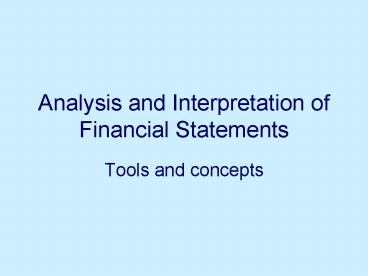Analysis and Interpretation of Financial Statements - PowerPoint PPT Presentation
1 / 25
Title:
Analysis and Interpretation of Financial Statements
Description:
Analysis and Interpretation of Financial Statements Tools and concepts Financial Analysis and Interpretation Tools and concepts What are tools? Financial Analysis and ... – PowerPoint PPT presentation
Number of Views:446
Avg rating:3.0/5.0
Title: Analysis and Interpretation of Financial Statements
1
Analysis and Interpretation of Financial
Statements
- Tools and concepts
2
Financial Analysis and Interpretation
- Tools and concepts
- What are tools?
3
Financial Analysis and Interpretation
- Tools and concepts (continued)
- What are tools?
- Items used to achieve some purpose
- They are NOT end results!!!!!!!!!!!!!!!!!!
- They are not precise
- They are only as good as the raw material from
which they are derived - Accounting information is based on estimates so
tools are estimates
4
Financial Analysis and Interpretation
- Tools and concepts (continued)
- What are concepts?
5
Financial Analysis and Interpretation
- Tools and concepts (continued)
- What are concepts?
- Notions general ideas
- Are NOT precise measurements!!!!
- Are NOT exact formulas to be memorized!!!
- Are EXAMPLES of what users of financial reports
use in practice
6
Financial Analysis and Interpretation
- Purpose of financial analysis and interpretation
- Primary focus on investors others find useful
(e.g. creditors) - Primary interest is in value
- Have views of enterprise been borne out?
- Expectations about future
7
Financial Analysis and Interpretation
- Two basic types of tools and approaches
- Trends same enterprise over time
- Cross sectional at single point in time, often
in comparison with other enterprises - Users use mixture which vary among situations
8
Financial Analysis and Interpretation
- Two basic types of tools and approaches - trends
and cross sectional (continued) - Lecture focuses on cross sectional
- Why?
9
Financial Analysis and Interpretation
- Two basic types of tools and approaches - trends
and cross sectional (continued) - Lecture focuses on cross sectional
- Why?
- Trends adequately covered in textbook
- BUT, textbook has only EXAMPLES!!!!
- Trend follows logically after cross-sectional
10
Financial Analysis and Interpretation
- Liquidity and solvency
- What do terms mean?
11
Financial Analysis and Interpretation
- Liquidity and solvency-meaning?
- Liquidity net liquid assets current
- Liquid varies
- Generally cash and equivalents
- Assets becoming cash shortly
- shortly varies.
- Solvencypay amounts when due
- Can be un-liquid but solvent!!!!!!!!!!
12
Financial Analysis and Interpretation
- Liquidity and solvency tools at point in time
- Current ratio
- Quick ratio
- Cash ratio
- Many slight variations in computation
13
Financial Analysis and Interpretation
- Liquidity and solvency toolsturnovers
- Working capital to Sales-variations
- Inventory turnover and days
- Trade receivables turnover and days
- Trade payables turnover and days
14
Financial Analysis and Interpretation
- Liquidity and solvency toolslong term solvency
and risk (gearing) - Debt ratio
- Debt total assets
- Debt liabilities owners equity
- Debt to owners equity
- Assume debt and equity separate!!!
15
Financial Analysis and Interpretation
- Operating performance
- Return on investment (ROI)
- Concept, not a computation
- Relation of profit (can be estimated many ways)
to invested capital (can be estimated many ways)
16
Financial Analysis and Interpretation
- Operating performance
- Possible ways to estimate profits
- Net income
- Income before minority interests
- Operating income (EBIT)
- EBITDA discredited not allowed to be reported
in some countries (e.g. USA)
17
Financial Analysis and Interpretation
- Operating performance (continued)
- Return on assets (ROA or ROTA)
- Relates profit (computed various ways) to ASSETS
- Generally, how well enterprises uses its
resources - Use of EBIT in textbook is EXAMPLE
18
Financial Analysis and Interpretation
- Operating performance ROTA (continued)
- Major strength is ability to decompose
- Margin on sales (income sales)
- Asset turnover (sales assets)
- Widely used Anglo-Saxon concept
19
Financial Analysis and Interpretation
- Operating performance (continued)
- Return on Equity (ROE)
- Income Owners equity
- EAT in text is an EXAMPLE!!!!
- Minority interest often excluded from both
numerator and denominator
20
Financial Analysis and Interpretation
- Operating performance ROE (continued)
- Indicator of use of shareholders investment
- Indicator of increase in shareholder value
21
Financial Analysis and Interpretation
- Operating performance ROE (continued)
- Compare with ROA to assess consequences of
gearing - Assumes that owners equity can be separated from
debt!!!!!!!!!!!!!!
22
Financial Analysis and Interpretation
- Investment ratios
- Earnings per share (EPS)
- Very complex computations
- Focus on understanding and interpreting, not
computing - Assumes owners equity is separate from debt
- Useful only if shares widely held
23
Financial Analysis and Interpretation
- Investment ratios-EPS (continued)
- Basic profit average shares
- Eliminate minority interest and preference
dividends - Average shares adjusted for bonus and splits
24
Financial Analysis and Interpretation
- Investment ratios-EPS (continued)
- Diluted assumes all possible future shares from
conversions and options become issued - Worst case scenario
- Hypothetical!!!!!!!!!!!!!!!
25
Financial Analysis and Interpretation
- Investment ratios-others
- Price earnings
- Dividend ratios
- Market to book
- See textbook
- Not widely used in Europe (but may be in the
future)































